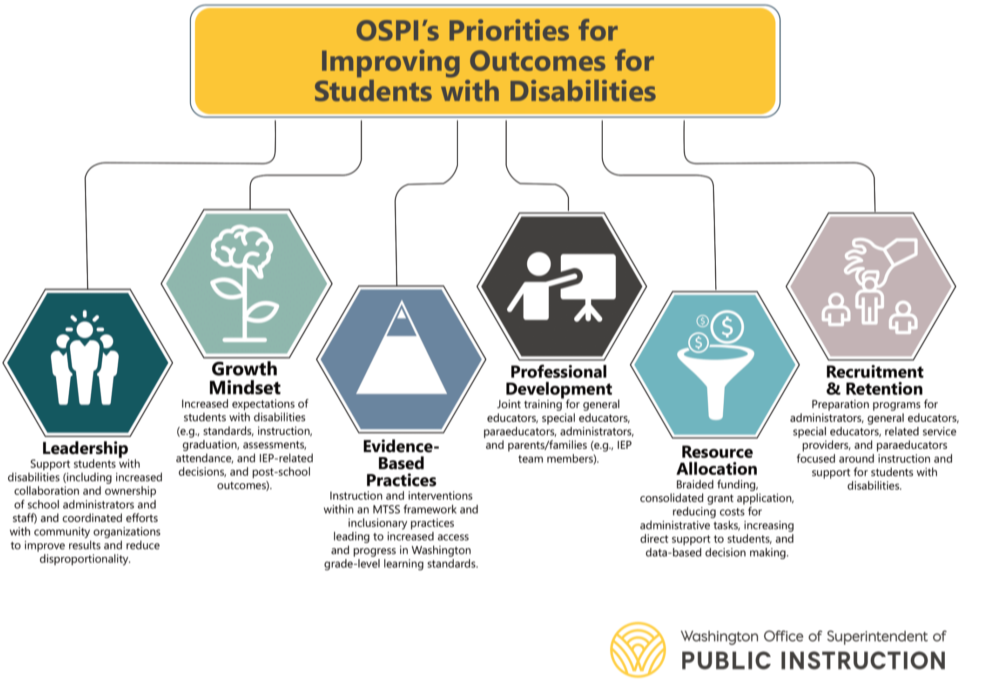

Helpful Resources & Links

Student Services in the Tenino School District
Student Services works with families to meet the needs of students with disabilities, both students in special education and those with 504 plans. Supporting students takes a team–which includes the student, parent(s)/ guardian(s), general and/or special education teachers, administrators, and, sometimes, other service providers. Together, we support students to improve achievement, access instruction through modernized practices, and prepare for college and career readiness.
Special Education
The Tenino School district provides a free, appropriate public education for eligible special education students between the ages of birth through twenty-one. A full continuum of placement options are available, based on the child’s educational needs. Parents, students, and educators work collaboratively as members of a team to determine eligibility and the appropriateness of educational interventions.
An evaluation is then completed and the parents and educational team determines if a child is eligible for special education services. If eligible, the district works with the parents to identify an appropriate educational program and classroom accommodations and completes a document called an Individualized Educational Program (IEP). This program is designed to ensure the student receives an appropriate educational program designed specifically to meet his/her educational needs in the least restrictive program possible.
Section 504 and Students with Disabilities
Section 504 of the Rehabilitation Act of 1973, commonly called "Section 504," is a federal law that protects students from discrimination based on disability. This law applies to all programs and activities that receive funding from the federal government-including Washington public schools
Accessing Support
Pre-Referral Process: Each building has a student support team to identify students in need of additional academic or behavioral support as part of our Multi Tiered System of Support (MTSS). The building team reviews multiple data points regarding student performance, including a child’s academic performance, behavioral progress, and attendance and develops plans to provide appropriate interventions as a part of the general education program. These interventions are monitored to determine whether adjustments or additional interventions are necessary. If multiple interventions are unsuccessful and the child is not showing progress, the team or any other involved individual may then submit a referral to special education or suggest consideration of a 504 plan depending on the circumstances.
Individualized Education Program (IEP)
An Individualized Education Program (IEP) is a written statement for a student eligible for special education that is developed, reviewed, and revised in accordance with state and federal laws. The IEP guides your student's learning while in special education. It describes the amount of time that your student will spend receiving special education, any related services your student will receive, and the academic/behavioral goals and expectations for the year.
Supporting Students
Each student who qualifies for special education services has an IEP created for that specific student to meet his/her education need. A student may be served in a variety of settings which include, but are not limited to, the following:
Services in the general education classroom: A student may be served in the general education classroom. This would include specially designed instruction in each area of eligibility which is designed and monitored by the special education teacher but delivered by the classroom teacher.
Targeted Learning Center: A student may be “pulled out” of their general education environment to receive specially designed instruction in his/her area(s) of eligibility in an alternative environment. The materials used for instruction may vary from the general education materials. The amount of time a student is served in a Targeted Learning Center is based on the student needs.
Intensive Learning Center: A student may require an alternative placement program for the majority of the day. The student may be eligible to receive services in reading, math, written language, independent living skills, vocational training, recreational training, and behavior in this alternative setting. Students participate with peers as appropriate to meet their individual needs.
Itinerant Services: A student may require targeted services in speech, language, and motor skills. Services are provided to these students in a “pull out” model or through consultation with instructional staff. These services are designed and monitored by a certified speech therapist or occupational therapist.
Your student's IEP team will meet at least once a year to talk about your student’s progress and make any needed changes to the program. The required members of your student’s IEP team includes:
The student's parent(s) or guardian(s);
At least one of the student's general education teachers (if s/he is participating or could possibly participate in general education);
At least one special education teacher;
A representative of the school district who is (1) qualified to provide, or supervises the provision of, specially designed instruction to meet the unique needs of students with disabilities, and (2) is knowledgeable about the general curriculum and the availability of resources within the district;
An individual who can interpret evaluation results and the related instructional implications;
Other individuals, at the discretion of the parent or the district, who have knowledge or special expertise regarding your student, including related services personnel, if appropriate; and
Your student, if appropriate.
Overall, the IEP team is responsible for identifying and evaluating your student, developing, reviewing, and/or revising your student's IEP, and determining the placement or setting where your student will receive her/his special education services in accordance with the IEP.

